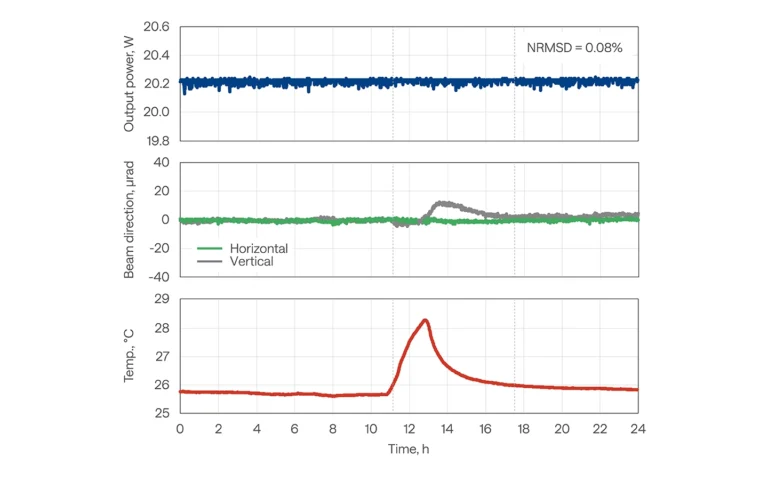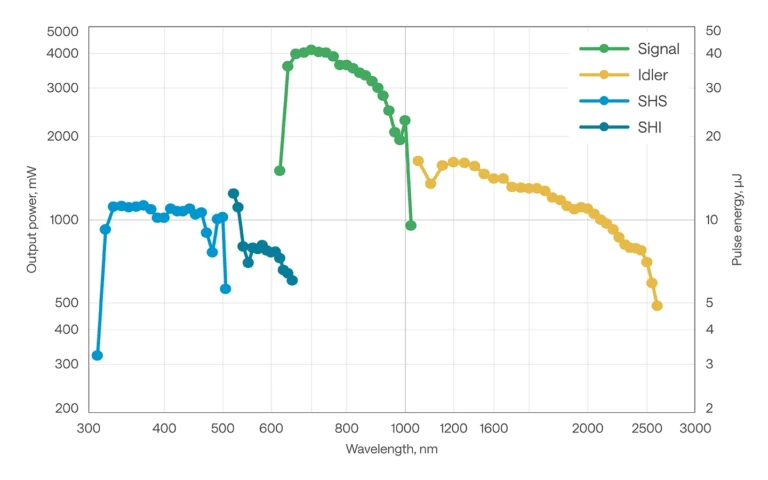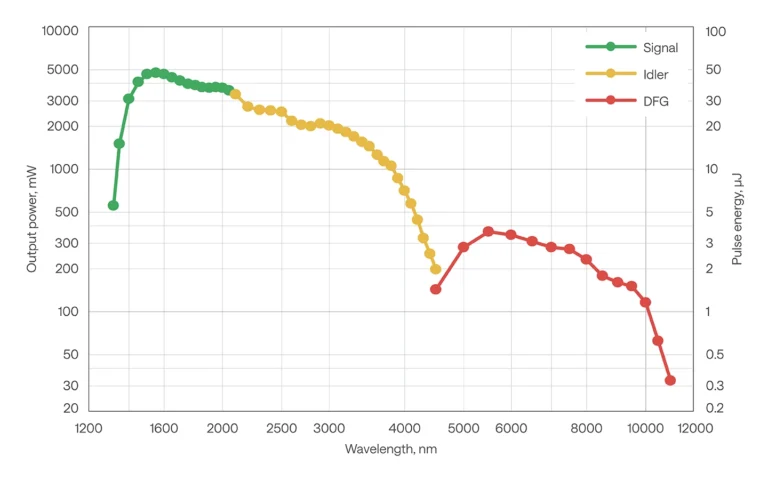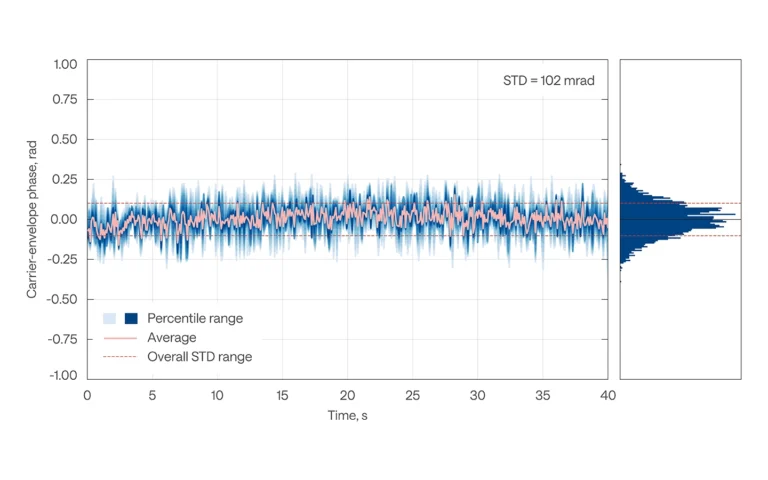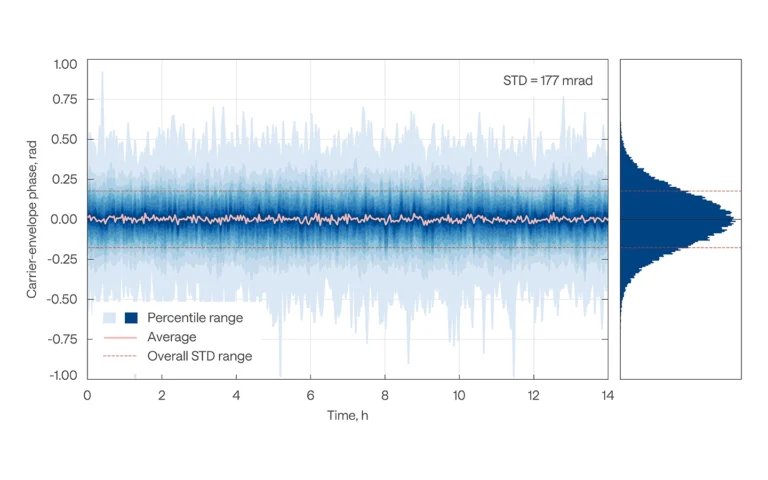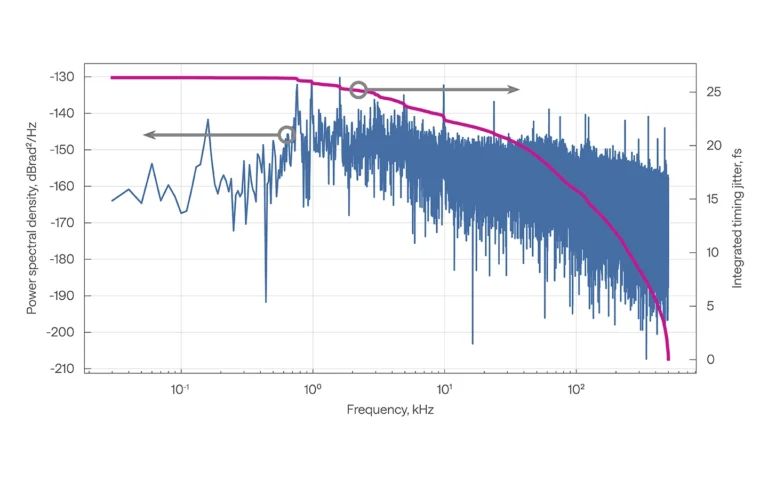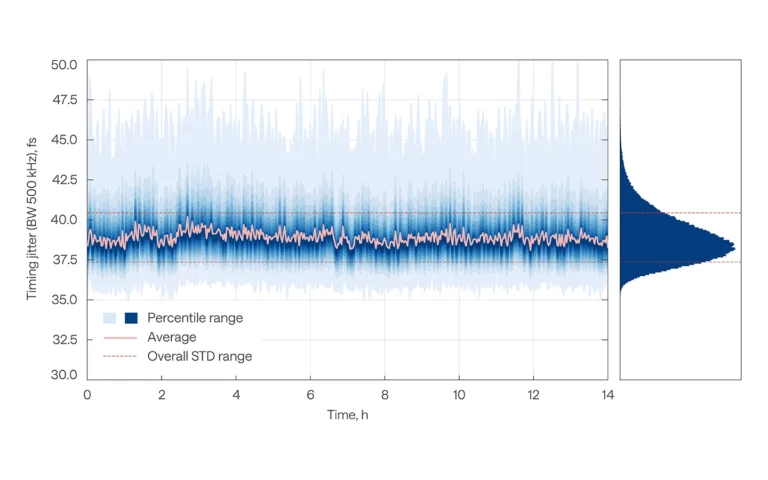Modular-Design Femtosecond Lasers for Industry and Science
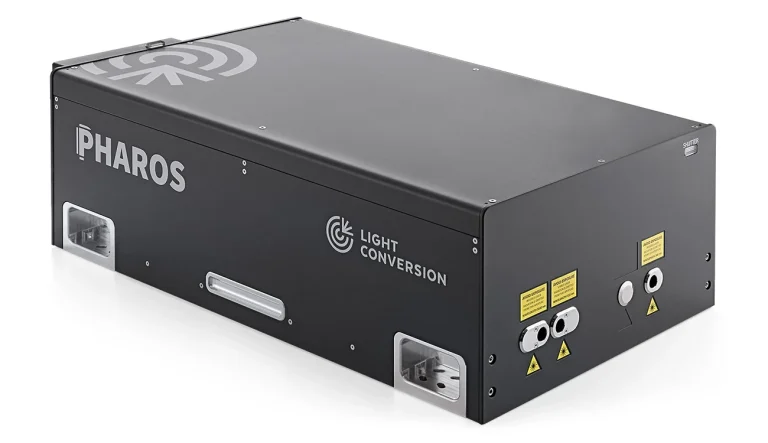
- Maximum pulse energy of up to 4 mJ
- Down to < 100 fs right at the output
- Tunable pulse duration, 100 fs – 20 ps
- Pulse-on-demand and BiBurst for pulse control
- Automated harmonics up to the 5th or tunable extensions
- CEP stabilization or repetition rate locking
PHAROS femtosecond lasers combine multi‑millijoule pulse energy and high average power, featuring a robust optomechanical design optimized for both scientific and industrial applications. The thermally stabilized and sealed design ensures seamless integration into various optical setups and machining workstations, delivering exceptional laser lifetime and stable operation across varying environments.
PHAROS provides unparalleled versatility, covering applications that would typically require multiple laser systems. Its key tunable parameters include pulse duration (100 fs – 20 ps), repetition rate (single-shot – 1 MHz), pulse energy (up to 4 mJ), and average power (up to 20 W).
The built-in pulse picker enables a pulse-on-demand mode, further enhancing operational flexibility. Additionally, the versatility of PHAROS femtosecond lasers can be further extended by a variety of options, including carrier-envelope phase (CEP) stabilization, repetition rate locking to an external source, automated harmonic modules, and optical parametric amplifiers.
| Model | PH2-10W | PH2-20W-SP | PH2-20W-SP | PH2-20W-SP | PH2-4mJ | PH2-UP | PH2-UP |
|---|---|---|---|---|---|---|---|
| Model | PH2-10W | PH2-20W-SP | PH2-4mJ | PH2-UP | |||
| Output characteristics | |||||||
| Center wavelength 1) | 1030 ± 10 nm | 1030 ± 10 nm | 1030 ± 10 nm | 1030 ± 10 nm | 1030 ± 10 nm | 1030 ± 10 nm | 1030 ± 10 nm |
| Center wavelength 1) | 1030 ± 10 nm | ||||||
| Maximum output power | 10 W | 20 W | 20 W | 20 W | 20 W | 20 W | 20 W |
| Maximum output power | 10 W | 20 W | |||||
| Pulse duration 2) | < 290 fs | < 190 fs | < 190 fs | < 190 fs | < 450 fs 3) | < 100 fs | < 100 fs |
| Pulse duration 2) | < 290 fs | < 190 fs | < 450 fs 3) | < 100 fs | |||
| Pulse duration tuning range | 290 fs – 10 ps (20 ps on request) | 190 fs – 10 ps (20 ps on request) | 190 fs – 10 ps (20 ps on request) | 190 fs – 10 ps (20 ps on request) | 450 fs – 10 ps | 100 fs – 10 ps | 100 fs – 10 ps |
| Pulse duration tuning range | 290 fs – 10 ps (20 ps on request) | 190 fs – 10 ps (20 ps on request) | 450 fs – 10 ps | 100 fs – 10 ps | |||
| Maximum pulse energy | 0.2 mJ | 0.4 mJ | 1 mJ | 2 mJ | 4 mJ | 0.4 mJ | 1 mJ |
| Repetition rate | Single-shot – 1 MHz | Single-shot – 1 MHz | Single-shot – 1 MHz | Single-shot – 1 MHz | Single-shot – 1 MHz | Single-shot – 1 MHz | Single-shot – 1 MHz |
| Repetition rate | Single-shot – 1 MHz | ||||||
| Pulse selection | Single-shot, pulse-on-demand, any fundamental repetition rate division | Single-shot, pulse-on-demand, any fundamental repetition rate division | Single-shot, pulse-on-demand, any fundamental repetition rate division | Single-shot, pulse-on-demand, any fundamental repetition rate division | Single-shot, pulse-on-demand, any fundamental repetition rate division | Single-shot, pulse-on-demand, any fundamental repetition rate division | Single-shot, pulse-on-demand, any fundamental repetition rate division |
| Pulse selection | Single-shot, pulse-on-demand, any fundamental repetition rate division | ||||||
| Polarization | Linear, horizontal | Linear, horizontal | Linear, horizontal | Linear, horizontal | Linear, horizontal | Linear, horizontal | Linear, horizontal |
| Polarization | Linear, horizontal | ||||||
| Beam quality, M2 | < 1.2 | < 1.2 | < 1.3 | < 1.3 | < 1.3 | < 1.2 | < 1.2 |
| Beam quality, M2 | < 1.2 | < 1.3 | < 1.2 | ||||
| Beam diameter 4) | 3.3 ± 0.5 mm | 4.0 ± 0.5 mm | 4.5 ± 0.5 mm | 6.8 ± 0.7 mm | 6.8 ± 0.7 mm | 4.5 ± 0.5 mm | 6.0 ± 0.5 mm |
| Beam diameter 4) | 3.3 ± 0.5 mm | 4.0 ± 0.5 mm | 4.5 ± 0.5 mm | 6.8 ± 0.7 mm | 4.5 ± 0.5 mm | 6.0 ± 0.5 mm | |
| Beam pointing stability | < 20 µrad/°C | < 20 µrad/°C | < 20 µrad/°C | < 20 µrad/°C | < 20 µrad/°C | < 20 µrad/°C | < 20 µrad/°C |
| Beam pointing stability | < 20 µrad/°C | ||||||
| Pre-pulse contrast | < 1 : 1000 | < 1 : 1000 | < 1 : 1000 | < 1 : 1000 | < 1 : 1000 | < 1 : 1000 | < 1 : 1000 |
| Pre-pulse contrast | < 1 : 1000 | ||||||
| Post-pulse contrast | < 1 : 200 | < 1 : 200 | < 1 : 200 | < 1 : 200 | < 1 : 200 | < 1 : 200 | < 1 : 200 |
| Post-pulse contrast | < 1 : 200 | ||||||
| Pulse-to-pulse energy stability, 24 h 5) | < 0.5% | < 0.5% | < 0.5% | < 0.5% | < 0.5% | < 0.5% | < 0.5% |
| Pulse-to-pulse energy stability, 24 h 5) | < 0.5% | ||||||
| Long-term power stability, 100 h 5) | < 0.5% | < 0.5% | < 0.5% | < 0.5% | < 0.5% | < 0.5% | < 0.5% |
| Long-term power stability, 100 h 5) | < 0.5% | ||||||
| Main options | |||||||
| Oscillator output 6) | 1 – 7 W, 50 – 250 fs, ≈ 1035 nm, ≈ 76 MHz | 1 – 7 W, 50 – 250 fs, ≈ 1035 nm, ≈ 76 MHz | 1 – 7 W, 50 – 250 fs, ≈ 1035 nm, ≈ 76 MHz | 1 – 7 W, 50 – 250 fs, ≈ 1035 nm, ≈ 76 MHz | 1 – 7 W, 50 – 250 fs, ≈ 1035 nm, ≈ 76 MHz | 1 – 7 W, 50 – 250 fs, ≈ 1035 nm, ≈ 76 MHz | 1 – 7 W, 50 – 250 fs, ≈ 1035 nm, ≈ 76 MHz |
| Oscillator output 6) | 1 – 7 W, 50 – 250 fs, ≈ 1035 nm, ≈ 76 MHz | ||||||
| Harmonic generator 7) | 515 nm, 343 nm, 257 nm, or 206 nm | 515 nm, 343 nm, 257 nm, or 206 nm | 515 nm, 343 nm, 257 nm, or 206 nm | 515 nm, 343 nm, 257 nm, or 206 nm | 515 nm, 343 nm, 257 nm, or 206 nm | 515 nm, 343 nm, 257 nm, or 206 nm | 515 nm, 343 nm, 257 nm, or 206 nm |
| Harmonic generator 7) | 515 nm, 343 nm, 257 nm, or 206 nm | ||||||
| Optical parametric amplifier 8) | UV – MIR | UV – MIR | UV – MIR | UV – MIR | UV – MIR | UV – MIR | UV – MIR |
| Optical parametric amplifier 8) | UV – MIR | ||||||
| BiBurst mode | Tunable GHz and MHz burst with burst-in-burst capability | Tunable GHz and MHz burst with burst-in-burst capability | Tunable GHz and MHz burst with burst-in-burst capability | Tunable GHz and MHz burst with burst-in-burst capability | Tunable GHz and MHz burst with burst-in-burst capability | Tunable GHz and MHz burst with burst-in-burst capability | Tunable GHz and MHz burst with burst-in-burst capability |
| BiBurst mode | Tunable GHz and MHz burst with burst-in-burst capability | ||||||
| CEP stabilization | Refer to CEP stabilization for PHAROS | Refer to CEP stabilization for PHAROS | Refer to CEP stabilization for PHAROS | Refer to CEP stabilization for PHAROS | Refer to CEP stabilization for PHAROS | Refer to CEP stabilization for PHAROS | Refer to CEP stabilization for PHAROS |
| CEP stabilization | Refer to CEP stabilization for PHAROS | ||||||
| Repetition rate locking | Refer to Repetition rate locking for PHAROS | Refer to Repetition rate locking for PHAROS | Refer to Repetition rate locking for PHAROS | Refer to Repetition rate locking for PHAROS | Refer to Repetition rate locking for PHAROS | Refer to Repetition rate locking for PHAROS | Refer to Repetition rate locking for PHAROS |
| Repetition rate locking | Refer to Repetition rate locking for PHAROS | ||||||
| Physical dimensions | |||||||
| Laser head (L × W × H) 9) | 730 × 419 × 230 mm | 730 × 419 × 230 mm | 730 × 419 × 230 mm | 730 × 419 × 230 mm | 827 × 492 × 250 mm | 770 × 419 × 230 mm | 770 × 419 × 230 mm |
| Laser head (L × W × H) 9) | 730 × 419 × 230 mm | 827 × 492 × 250 mm | 770 × 419 × 230 mm | ||||
| Chiller (L × W × H) | 590 × 484 × 267 mm | 590 × 484 × 267 mm | 590 × 484 × 267 mm | 590 × 484 × 267 mm | 590 × 484 × 267 mm | 590 × 484 × 267 mm | 590 × 484 × 267 mm |
| Chiller (L × W × H) | 590 × 484 × 267 mm | ||||||
| 24 V DC power supply (L × W × H) 9) | 280 × 144 × 49 mm | 280 × 144 × 49 mm | 280 × 144 × 49 mm | 280 × 144 × 49 mm | 280 × 144 × 49 mm | 280 × 144 × 49 mm | 280 × 144 × 49 mm |
| 24 V DC power supply (L × W × H) 9) | 280 × 144 × 49 mm | ||||||
| Environmental & utility requirements | |||||||
| Operating temperature | 15 – 30 ºC (air conditioning recommended) | 15 – 30 ºC (air conditioning recommended) | 15 – 30 ºC (air conditioning recommended) | 15 – 30 ºC (air conditioning recommended) | 15 – 30 ºC (air conditioning recommended) | 15 – 30 ºC (air conditioning recommended) | 15 – 30 ºC (air conditioning recommended) |
| Operating temperature | 15 – 30 ºC (air conditioning recommended) | ||||||
| Relative humidity | < 80% (non-condensing) | < 80% (non-condensing) | < 80% (non-condensing) | < 80% (non-condensing) | < 80% (non-condensing) | < 80% (non-condensing) | < 80% (non-condensing) |
| Relative humidity | < 80% (non-condensing) | ||||||
| Laser | Laser | Laser | Laser | Laser | Laser | Laser | Laser |
| Laser | |||||||
| Electrical requirements | 100 V AC, 12 A – 240 V AC, 5 A; 50 – 60 Hz | 100 V AC, 12 A – 240 V AC, 5 A; 50 – 60 Hz | 100 V AC, 12 A – 240 V AC, 5 A; 50 – 60 Hz | 100 V AC, 12 A – 240 V AC, 5 A; 50 – 60 Hz | 100 V AC, 12 A – 240 V AC, 5 A; 50 – 60 Hz | 100 V AC, 12 A – 240 V AC, 5 A; 50 – 60 Hz | 100 V AC, 12 A – 240 V AC, 5 A; 50 – 60 Hz |
| Electrical requirements | 100 V AC, 12 A – 240 V AC, 5 A; 50 – 60 Hz | ||||||
| Rated power | 1000 W | 1000 W | 1000 W | 1000 W | 1000 W | 1000 W | 1000 W |
| Rated power | 1000 W | ||||||
| Power consumption | 600 W | 600 W | 600 W | 600 W | 600 W | 600 W | 600 W |
| Power consumption | 600 W | ||||||
| Chiller | Chiller | Chiller | Chiller | Chiller | Chiller | Chiller | Chiller |
| Chiller | |||||||
| Electrical requirements | 100 – 230 V AC; 50 – 60 Hz | 100 – 230 V AC; 50 – 60 Hz | 100 – 230 V AC; 50 – 60 Hz | 100 – 230 V AC; 50 – 60 Hz | 100 – 230 V AC; 50 – 60 Hz | 100 – 230 V AC; 50 – 60 Hz | 100 – 230 V AC; 50 – 60 Hz |
| Electrical requirements | 100 – 230 V AC; 50 – 60 Hz | ||||||
| Power consumption | 1400 W | 1400 W | 1400 W | 1400 W | 1400 W | 1400 W | 1400 W |
| Power consumption | 1400 W | ||||||
| Rated power | 1000 W | 1000 W | 1000 W | 1000 W | 1000 W | 1000 W | 1000 W |
| Rated power | 1000 W | ||||||
| Model | PH2-10W | PH2-20W-SP | PH2-20W-SP | PH2-20W-SP | PH2-4mJ | PH2-UP | PH2-UP |
|---|---|---|---|---|---|---|---|
| Model | PH2-10W | PH2-20W-SP | PH2-4mJ | PH2-UP | |||
- Precise wavelengths for specific models are available upon request.
- Assuming a Gaussian pulse shape.
- Pulse duration can be reduced to < 250 fs if a pulse peak intensity of > 50 GW/cm2 is tolerated by the customer setup.
- FW 1/e2, measured at laser output, using maximum pulse energy.
- Under stable environmental conditions. Expressed as normalized root mean squared deviation (NRMSD).
- Available simultaneously. Contact sales@lightcon.com for more details or customized solutions.
- Integrated. For an external harmonic generator, refer to HIRO.
- Integrated. For more options and OPAs for -4mJ and -UP models, refer to Wavelength-Tunable Sources.
- Dimensions depend on laser configuration and integrated options.
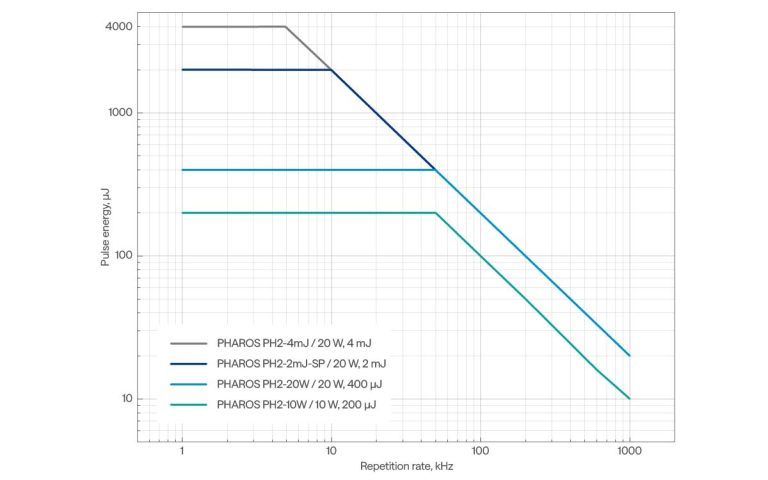
PHAROS pulse energy vs fundamental repetition rate.
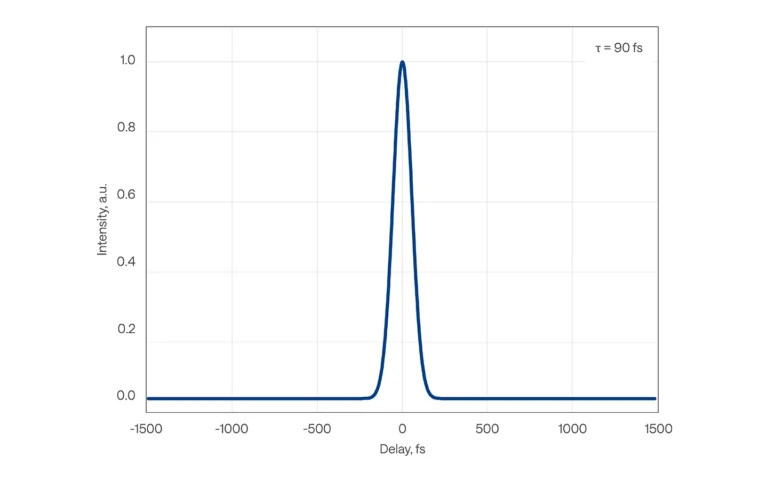
PHAROS-PH2-UP typical pulse duration.
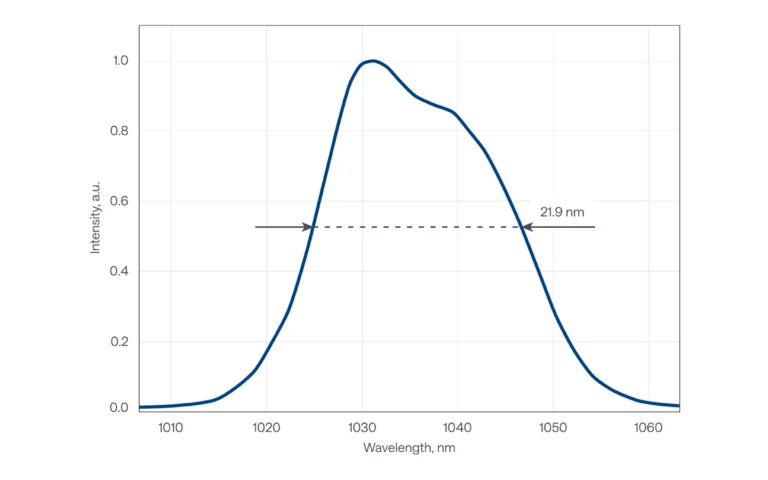
PHAROS-PH2-UP typical spectrum.
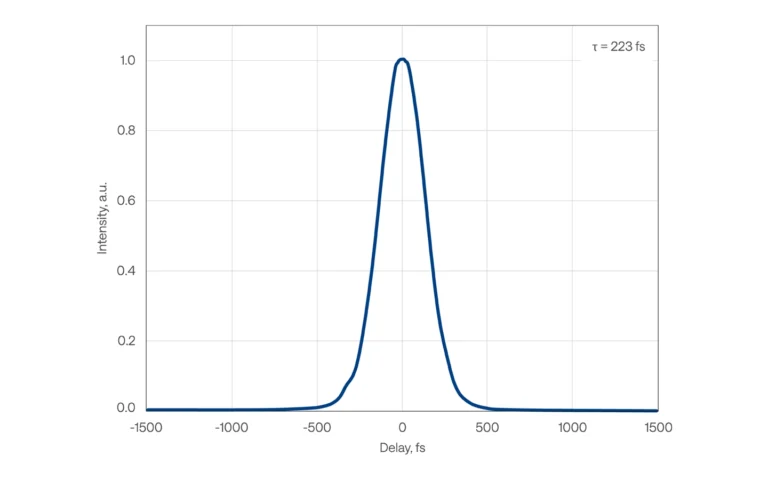
PHAROS-PH2-20W-SP typical pulse duration.
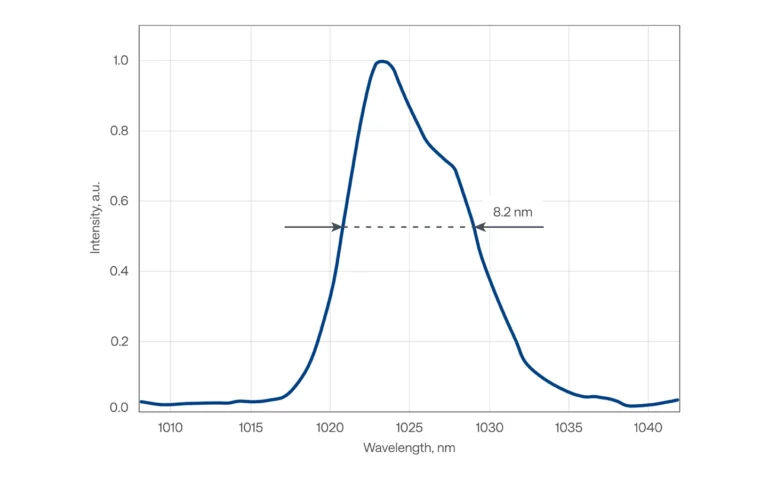
PHAROS-PH2-20W-SP typical spectrum.
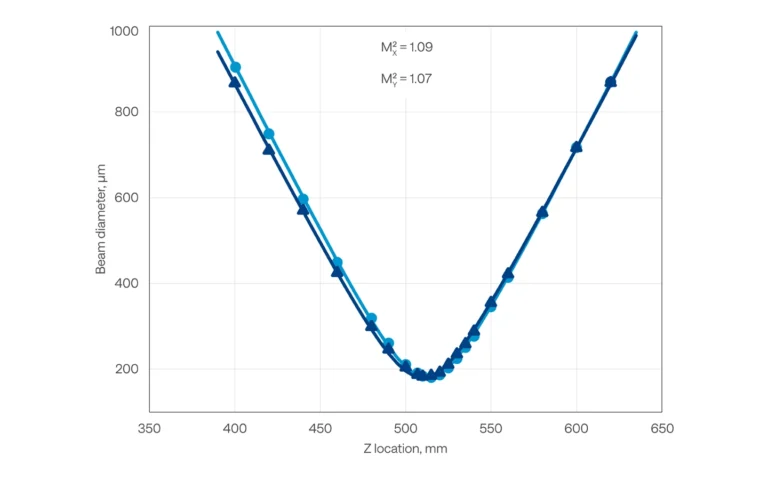
PHAROS typical M² measurement data.
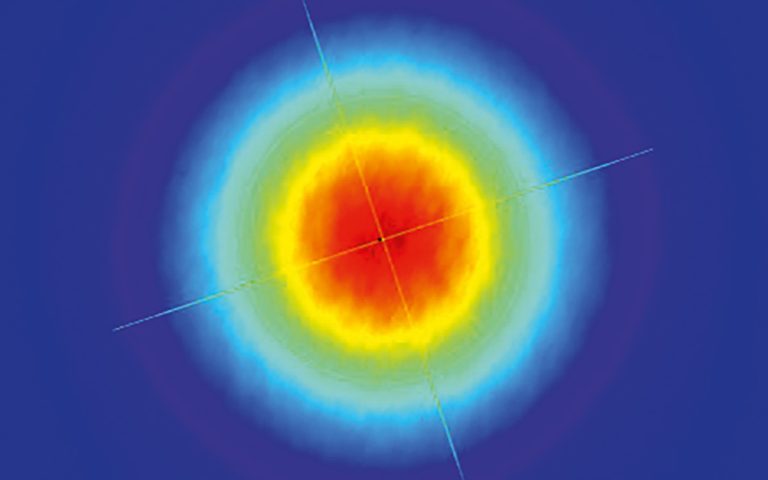
PHAROS typical near-field beam profile.

PHAROS typical far-field beam profile.

PHAROS-PH2 femtosecond laser.

PHAROS-PH2 femtosecond laser (rear view).
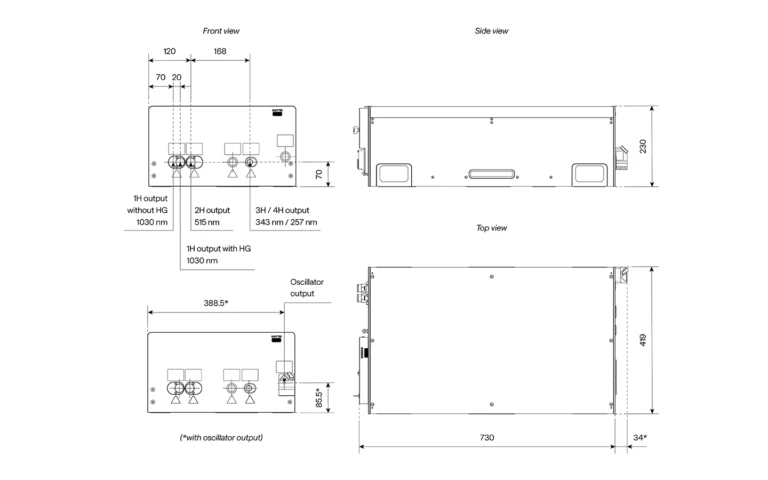
Drawing of PHAROS-PH2-10W or -20W-SP with a FEC or BiBurst option, or a harmonic generator.

Drawing of PHAROS-PH2-10W or -20W-SP with BiBurst and a harmonic generator, or PHAROS-PH2-UP without a harmonic generator.

Drawing of PHAROS-PH2-10W with an -HE harmonic generator option, or PHAROS-PH2-4mJ.
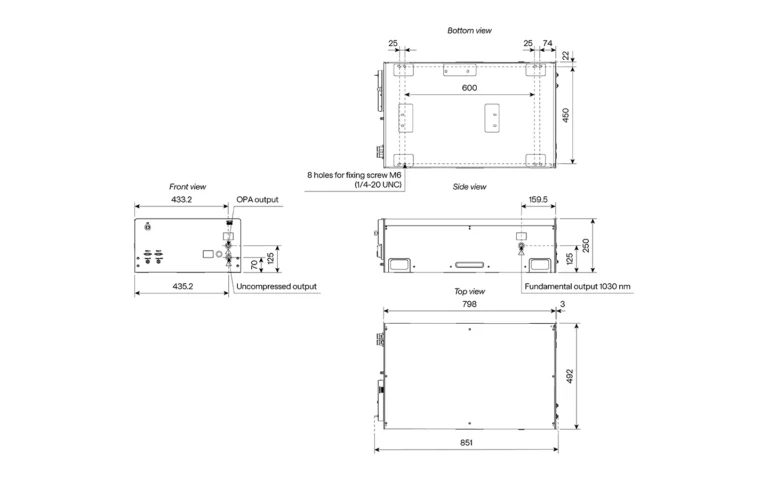
Drawing of PHAROS-PH2 with I-OPA-HP.
The drawings depend on the exact configuration. If crucial for integration, please contact sales@lightcon.com.
Product datasheet
Product datasheet
Product datasheet
Product datasheet
Application examples
Product catalog
Product catalog
Product catalog in Chinese
Product catalog in Korean


